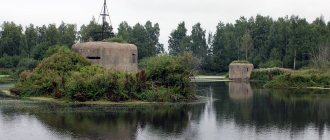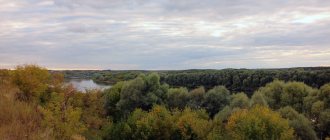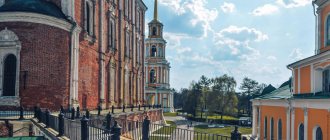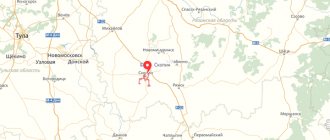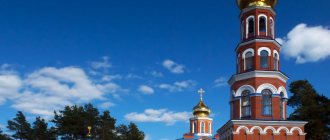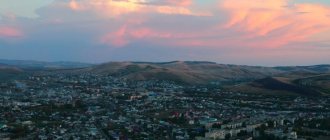Mikhaylov
Sights of Mikhailov
The best place to start getting to know Mikhailov is from the historical center - Marshal Golikov Street. history museum
is located here .
It features exhibitions dedicated to the ancient history of the city, the Middle Ages, the Great Patriotic War and the Soviet period.
Nearby at the intersection with Pronskaya Street on Red (formerly Cathedral) Square you can see a memorial sign. Archangel Cathedral stood here from the 16th to the 20th centuries.
.
Over its four-hundred-year history, it was rebuilt several times, the last time this happened at the end of the 19th century, when the temple was rebuilt according to the design of the architect K. Ton.
However, in 1936 the cathedral was demolished; today its model can be seen in the local history museum. Currently, work is underway to restore the temple.
Literally a few steps from the square there is an architectural monument of the 18th century - Tax Izba
.
Initially, the treasury was located here, where taxes were collected, then the building changed owners several times and today belongs to the museum, which is raising funds for its restoration.
Nearby in the park on Cathedral Hill there is a monument to Archangel Michael
, the heavenly patron of the city.
This is the work of sculptor Oleg Sedov. Across the road you can see another monument - a memorial to those who fell in the Great Patriotic War and a T-34 tank
.
This is a real fighting vehicle that took part in the battles of Prokhorovka, in the battles for the liberation of Prague and in the storming of Berlin. By the way, the monument offers a magnificent view of Mikhailov.
Another attraction of the city center is the bridge over the Pronya River
. It was built in 1898 according to the design of the architect A. Bantle.
It is notable because it is riveted and constructed from large metal parts. In addition, traces of shells from the Great Patriotic War period remained on its supports. Currently the bridge is pedestrian.
The Church of the Nativity of the Virgin Mary is also noteworthy.
- an architectural monument of federal significance. Built at the end of the 18th century, it was originally part of the Nativity of the Mother of God Monastery, which was later abolished.
During the years of Soviet power it was closed and used as a salt warehouse; at the end of the 20th century it was handed over to believers.
Next door on Pronskaya Street there is a former district zemstvo building
, and currently it houses the city administration. The construction dates back to 1912, the architect is A. Bantle.
This is a striking example of provincial modernism; on the walls of the building you can see the Mikhailov coat of arms and other decorative elements.
Not far from here, on the banks of the Leshchinsky stream, there is the “Blue Mountain” settlement.
- archaeological monument of the 12th-14th centuries. In this place there was a settlement of the Vyatichi Slavs before it was plundered by the Mongol-Tatar hordes. Archaeological finds from the settlement can be seen in the local history museum.
A few kilometers from Mikhailov there is another interesting place - the Intercession Convent
. It was founded in 1507 near Ryazan (now in that place the village of Agro-Pustyn), and in 1819 it was moved to Mikhailov. In the 20th century, the monastery was completely destroyed; its restoration is currently underway.
Another monument of religious architecture is the Church of the Nativity of Christ
on Prudskaya street. The temple on this site existed for a long time, and at the turn of the 18th and 19th centuries it was rebuilt in stone in the provincial Baroque style.
It was not closed under Soviet rule, which is why it is well preserved. Today it is the cathedral of the Ryazan and St. Michael's diocese.
There is another interesting place on Truzhenits Street - the Mikhailovsky Lace Museum
. Here you can see both the works of local craftswomen and samples of bobbins from different countries.
In addition, guests are invited to take part in lace-making workshops. The museum operates at the Mikhailovskaya Lacemaker factory, which continues the traditions of the local unique artistic craft.
In the Mikhailovsky district on the banks of the Lubyanka River there is a unique monument - the Lubyanskoye ancient settlement
, striking in its size. Here in ancient times stood a city that perished in 1237 during the invasion of Batu. It has not yet been possible to establish what kind of city this was, but it is believed that this is the famous chronicle Belgorod.
Another ancient settlement - Izheslavl
— is located on the banks of the Prony River near the village of the same name. It is believed, but not proven, that the ancient Izheslavets stood on this site, destroyed by Batu.
The settlement is notable for its three rows of ramparts and ditches, which indicates the reliable fortification of the city, which, unfortunately, did not save it from ruin. In addition to being historical, the place has natural value: many rare plants grow here.
Not far from the village of Krasnaya Gorka, Mikhailovsky district, you can see the beautiful estate of A.P. Ermolov
, one of the favorites of Catherine II. Of the buildings here, the Kazan Church, the round barnyard and the manor house itself have been preserved, but its interior decoration has been lost.
Now the estate is part of the courtyard of the Sretensky Monastery, so access to it is limited.
There is another ancient estate in the Mikhailovsky district, which, unfortunately, is in ruins. This is the estate of landowner Gagarin
, located in the village of the Central Branch of the State Farm named after. Ilyich.
Two outbuildings, the ruins of a church and stables have survived to this day. The manor house itself was lost; it housed a school until the end of the 20th century; after its closure, the building was dismantled. The distillery that previously operated here has also been lost, but the alcohol storage facility has been preserved.
Links[edit]
Notes[edit]
- ^ abcde State Committee of the Russian Federation on Statistics. Committee of the Russian Federation for Standardization, Metrology and Certification. No. OK 019-95 January 1, 1997 “All-Russian classifier of objects of administrative-territorial division. Code 61 217", ed. changes No. 278 / 2015 dated January 1, 2016. (Goskomstat of the Russian Federation. Committee of the Russian Federation for Standardization, Metrology and Certification. No. OK 019-95 January 1, 1997. Russian classification of administrative divisions) (OKATO).
Code 61 217 , as amended by Amendment No. 278/2015 of January 1, 2016). - ^ abc State Committee of the Russian Federation on Statistics. Committee of the Russian Federation for Standardization, Metrology and Certification. No. OK 019-95 January 1, 1997 “All-Russian classifier of objects of administrative-territorial division. Code 61 217 500”, ed. changes No. 278 / 2015 dated January 1, 2016. (Goskomstat of the Russian Federation. Committee of the Russian Federation for Standardization, Metrology and Certification. No. OK 019-95 January 1, 1997. Russian classification of administrative divisions) (OKATO).
Code 61 217 500 , as amended by Amendment No. 278/2015 of January 1, 2016). - ^ a b Federal State Statistics Service (2011). “All-Russian Population Census 2010. Volume 1" [All-Russian Population Census 2010, vol. 1]. All-Russian Population Census 2010 [All-Russian Population Census 2010]
. Federal State Statistics Service. - "26. The size of the permanent population of the Russian Federation by municipalities as of January 1, 2022". Federal State Statistics Service. Retrieved January 23, 2022.
- ^ abcde Law No. 86-OZ
- "On the Calculation of Time". Official Internet portal of legal information
. June 3, 2011. Retrieved January 19, 2022. - Post office. Information and computing center of OASU RPO. ( Post office
).
Search for postal service objects ( postal Search for objects
) (in Russian) - ↑
Federal State Statistics Service of Russia (May 21, 2004).
“The population of Russia, the constituent entities of the Russian Federation as part of federal districts, urban settlements, settlements, settlements is 3 thousand or more people” [Population of Russia, its federal districts, federal districts, districts Urban settlements, rural settlements - administrative centers and rural settlements with a population of over 3,000] (XLS). All-Russian Population Census 2002
. - “All-Union Population Census of 1989. The current population of union and autonomous republics, autonomous regions and districts, territories, negative phenomena, urban settlements and rural district centers” [All-Union Population Census of 1989: current population of union and autonomous republics, Autonomous regions and districts , territories, regions, districts, urban settlements and villages performing the functions of district administrative centers. All-Union Population Census of 1989 [All-Union Population Census of 1989]
.
Institute of Demography of the National Research University: Higher School of Economics [Institute of Demography of the National Research University: Higher School of Economics]. 1989 - via Demoscope Weekly
.
Personal life
Stanislav had three beloved women, from each of whom children were born. He married for the first time in 1996 in Sochi to Inna Gorb. This marriage produced a son, Nikita. His wife helped Stas write songs, but as his popularity grew, family life fell apart. After the divorce in 2003, Mikhailov dedicated the song “Well, that’s all” to her.
The second chosen one is Natalya Zotova, who worked as a backup singer for Stanislav, accompanied him on tour, and is the cousin of the singer Valeria. After an affair with Mikhailov, Natalya remained pregnant; in 2005, her daughter Daria was born. The singer confirmed his paternity only in 2011.
Since 2006, she has been in a relationship with Inna Kanchelskis, the mother of two children from her first marriage to a famous football player. In 2009, their common daughter Ivanna was born. They got married in 2011, and a year later another daughter, Maria, was born. Inna’s eldest children, Andrei and Eva, live with their mother, which is why Stas is often called the father of six children in the press. The family lives in an elite Moscow apartment. Mikhailov is also the owner of a country house in the Moscow region, Sochi, the St. Petersburg restaurant “Kommunalka”, and a cottage in Montenegro.
Childhood and youth
Stanislav was born on April 27, 1969 in the city of Sochi. The Mikhailov family was not rich: father Vladimir Borisovich served as a civilian helicopter pilot. The man comes from the ancient city of Shemakha and has Azerbaijani roots. Mother Lyudmila Vasilievna worked as a nurse.
The future singer spent his childhood on the sunny shore of the Black Sea in a friendly circle of relatives. Stas was greatly influenced by his older brother Valery, who taught Mikhailov the first chords on the guitar and inspired him to become a pilot.
View this post on Instagram
A post shared by Stas Mihailov (@stas_mihailoff)
Stas Mikhailov in childhood with his older brother
After graduating from school, Stanislav went to Minsk to continue the family business and devote his life to the sky. The young man entered the civil aviation school, but 7 months were enough to give up on this dream. Stas left school and returned home. In Adler, he found work as a loader in a store. Mikhailov was ashamed of the craft and tried in every possible way to avoid acquaintances who might see a southerner doing such an activity.
Then Stas was drafted into the army. The singer was sent to Rostov-on-Don, where he served in the Air Force of the North Caucasus District. Thanks to his experience, Mikhailov was appointed driver at headquarters.
After the army, Stas returned to his hometown, where the artist’s creative biography began. Mikhailov became a businessman, worked part-time in a recording studio, and sang in restaurants in the evenings. The last 2 jobs gave the future star the opportunity to at least briefly look into the world of show business. Stanislav soon became a local celebrity, and this popularity pushed the soloist to take up music seriously.

